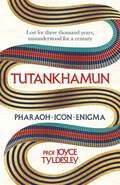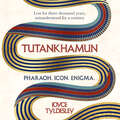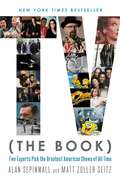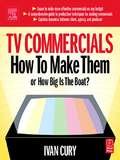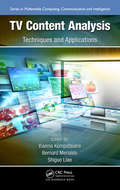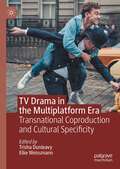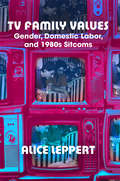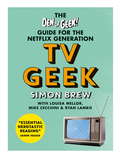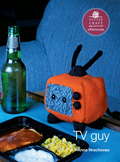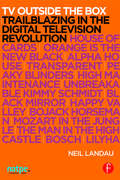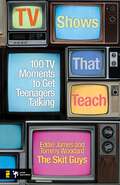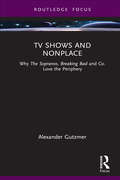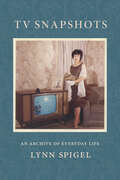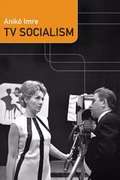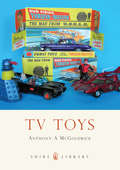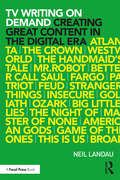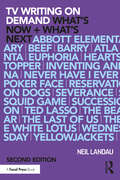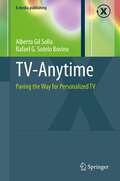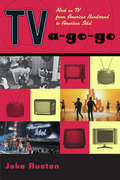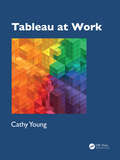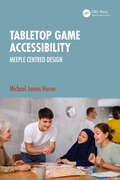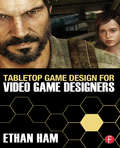- Table View
- List View
TUTANKHAMUN: 100 years after the discovery of his tomb leading Egyptologist Joyce Tyldesley unpicks the misunderstandings around the boy king's life, death and legacy
by Joyce TyldesleyPharaoh.Icon.Enigma.Lost for three thousand years, misunderstood for a century.A hundred years ago, a team of archaeologists in the Valley of the Kings made a remarkable discovery: a near-complete royal burial, an ancient mummy, and golden riches beyond imagination. The lost tomb of Tutankhamun ignited a media frenzy, propelled into overdrive by rumours of a deadly ancient curse. But amid the hysteria, many stories - including that of Tutankhamun himself - were distorted or forgotten.Tutankhamun: Pharaoh, Icon, Enigma takes a familiar tale and turns on its head. Leading Egyptologist Joyce Tyldesley has gathered ten unique perspectives together for the first time, including that of the teenage pharaoh and his family, ancient embalmers and tomb robbers, famous Western explorers and forgotten Egyptian archaeologists. It's a journey that spans from ancient Thebes in 1336 BCE, when a young king on a mission to restore his land met an unexpected and violent end, to modern Luxor in 1922 CE when the tomb's discovery led to a fight over ownership that continues to this day.Above all, this is the story of Tutankhamun, as he would have wanted to be remembered. Piecing together three thousand years of evidence and unpicking the misunderstandings that surround Egypt's most famous king, this book offers a vital reappraisal on his life, death and enduring legacy.
TUTANKHAMUN: 100 years after the discovery of his tomb leading Egyptologist Joyce Tyldesley unpicks the misunderstandings around the boy king's life, death and legacy
by Joyce TyldesleyA hundred years ago, a team of archaeologists in the Valley of the Kings made a remarkable discovery: a near-complete royal burial, an ancient mummy, and golden riches beyond imagination. The lost tomb of Tutankhamun ignited a media frenzy, propelled into overdrive by rumours of a deadly ancient curse. But amid the hysteria, many stories - including that of Tutankhamun himself - were distorted or forgotten.Tutankhamun: Pharaoh, Icon, Enigma takes a familiar tale and turns on its head. Leading Egyptologist Joyce Tyldesley has gathered ten unique perspectives together for the first time: that of the teenage pharaoh and his family, ancient embalmers and tomb robbers, famous Western explorers and forgotten Egyptian archaeologists. It's a journey that spans from ancient Thebes in 1336 BCE - when a young king on a mission to restore his land met an unexpected and violent end - to modern Luxor in 1922 CE - as the tomb's discovery led to a fight over ownership that continues to this day.Above all, this is the story of Tutankhamun, as he would have wanted to be remembered. Piecing together three thousand years of evidence and unpicking the misunderstandings that surround Egypt's most famous king, this audiobook offers a vital reappraisal on his life, death and enduring legacy.(P) 2022 Headline Publishing Group Ltd
TV (The Book): Two Experts Pick the Greatest American Shows of All Time
by Alan Sepinwall Matt Zoller Seitz<p>Is The Wire better than Breaking Bad? Is Cheers better than Seinfeld? What's the best high school show ever made? Why did Moonlighting really fall apart? Was the Arrested Development Netflix season brilliant or terrible? <p>For twenty years-since they shared a TV column at Tony Soprano's hometown newspaper-critics Alan Sepinwall and Matt Zoller Seitz have been debating these questions and many more, but it all ultimately boils down to this: What's the greatest TV show ever? <p>That debate reaches an epic conclusion in TV (THE BOOK). Sepinwall and Seitz have identified and ranked the 100 greatest scripted shows in American TV history. Using a complex, obsessively all- encompassing scoring system, they've created a Pantheon of top TV shows, each accompanied by essays delving into what made these shows great. From vintage classics like The Twilight Zone and I Love Lucy to modern masterpieces like Mad Men and Friday Night Lights, from huge hits like All in the Family and ER to short-lived favorites like Firefly and Freaks and Geeks, TV (THE BOOK) will bring the triumphs of the small screen together in one amazing compendium. <p> Sepinwall and Seitz's argument has ended. Now it's time for yours to begin! <P><b>A New York Times Bestseller</b>
TV Commercials: or, How Big is the Boat?
by Ivan CuryUnderstanding how commercials are made is the key to doing it right. This descriptive book is a step-by-step guide on the mechanics of creating a commercial from a production perspective. Making commercials on all types of budgets is addressed. There is material describing the roles and dynamics of the key players: the producer/director, agency, and client. This book outlines the requirements of each group so that everyone can understand and appreciate each other's needs.
TV Content Analysis: Techniques and Applications (Multimedia Computing, Communication And Intelligence Ser.)
by Yiannis Kompatsiaris Bernard Merialdo Shiguo LianThe rapid advancement of digital multimedia technologies has not only revolutionized the production and distribution of audiovisual content, but also created the need to efficiently analyze TV programs to enable applications for content managers and consumers. Leaving no stone unturned, TV Content Analysis: Techniques and Applications provides a de
TV Drama in the Multiplatform Era: Transnational Coproduction and Cultural Specificity
by Elke Weissmann Trisha DunleavyThis edited collection examines a new phase in the creation of transnational high-end drama in television’s current multiplatform era. Fuelled by the wider international exposure that internet distribution has brought to TV shows, this phase for high-end drama is one of unprecedented budgets and costs, frequent transnational coproduction and increased cultural diversification. While this drama continues to be facilitated by national broadcasters, fuelling the above trio of influences upon it has been the commissioning activity of multinational subscription-video-on-demand (SVoD) providers. This book showcases leading examples of transnational TV drama, produced outside the US, yet involving collaboration with US-owned SVoDs. It foregrounds some new potentials for drama creation in the context of its strategic importance to providers as different as national broadcasters and multinational SVoDs. This book helps to explain why today’s high-end dramas are demonstrating new elements of cultural specificity despite their common objective to engage a diverse international audience.
TV Family Values: Gender, Domestic Labor, and 1980s Sitcoms
by Alice LeppertDuring the 1980s, U.S. television experienced a reinvigoration of the family sitcom genre. In TV Family Values, Alice Leppert focuses on the impact the decade's television shows had on middle class family structure. These sitcoms sought to appeal to upwardly mobile “career women” and were often structured around non-nuclear families and the reorganization of housework. Drawing on Foucauldian and feminist theories, Leppert examines the nature of sitcoms such as Full House, Family Ties, Growing Pains, The Cosby Show, and Who's the Boss? against the backdrop of a time period generally remembered as socially conservative and obsessed with traditional family values.
TV Geek: The Den of Geek Guide for the Netflix Generation
by Simon BrewEssential nerdtastic reading! - Jason IssacsFrom the author of Den of Geek, this is the ultimate, nerdy television guide for TV geeks everywhere!TV Geek recounts the fascinating stories of cult-classic series, reveals the nerdy Easter eggs hidden in TV show sets, and demonstrates the awe-inspiring power of fandom, which has even been known to raise TV series from the dead. Includes:- How the live-action Star Wars TV show fell apart- The logistics and history of the crossover episode- The underrated geeky TV shows of the 1980s- The hidden details of Game of Thrones- Five Scandinavian crime thrillers that became binge hits - The Walking Dead, and the power of fandomTV series are now as big as Hollywood movies with their big budgets, massive stars, and ever-growing audience figures! TV Geek provides an insightful look at the fascinating history, facts and anecdotes behind the greatest (and not-so-great) shows.
TV Geek: The Den of Geek Guide for the Netflix Generation
by Simon BrewTV Geek recounts the fascinating stories of cult-classic series, reveals the nerdy Easter eggs hidden in TV show sets, and demonstrates the awe-inspiring power of fandom, which has even been known to raise TV series from the dead. Subjects include:- How the live-action Star Wars TV show fell apart- The logistics and history of the crossover episode- The underrated geeky TV shows of the 1980s- The hidden details of Game of Thrones- Five Scandinavian crime thrillers that became binge hits - The Walking Dead, and the power of fandomTV series now have the same budgets, stars, audience figures and cultural impact as Hollywood movies, and TV Geek provides an insightful look at the fascinating history, facts and anecdotes behind the greatest (and not-so-great) shows.This is the ultimate, nerdy television guide for TV geeks everywhere.
TV Guy: E-Pattern from Knitting Mochimochi (Potter Craft ePatterns)
by Anna HrachovecKnitting instructions.
TV Outside the Box: Trailblazing in the Digital Television Revolution (NATPE Presents)
by Neil LandauTV Outside the Box: Trailblazing in the Digital Television Revolution explores the new and exploding universe of on-demand, OTT (Over the Top) networks: Netflix, Amazon, Hulu, Crackle, CW Seed, Vimeo, AwesomenessTV, and many more. Featuring in-depth conversations with game-changing content creators, industry mavericks, and leading cultural influencers, TV Outside the Box is essential reading for anyone interested in the dynamics of a global media revolution – while it’s happening. Readers will discover: How the new "disruptors" of traditional television models are shaping the future of the television and feature film business. You’ll hear directly from the visionaries behind it all – from concept genesis to predictions for the future of streaming platforms; their strategies for acquisitions and development of new original content; and how the revolution is providing unprecedented opportunities for both established and emerging talent. What’s different about storytelling for the progressive, risk-taking networks who are delivering provocative, groundbreaking, binge-worthy content, without the restraints of the traditional, advertiser-supported programming model. Through interviews with the showrunners, content creators, and producers of dozens of trailblazing series – including Orange Is the New Black, House of Cards, Transparent, and many more – you’ll learn how and why the best and the brightest TV content creators and filmmakers are defining the new digital entertainment age – and how you can, too.
TV Scenic Design
by Gerald MillersonTV Scenic Design is a comprehensive resource for aspiring and practicing set designers. Summarizing the principles and practices of scenic design, it details design approaches, structures, and staging methods. TV Scenic Design is a comprehensive resource for aspiring and practicing set designers. Summarizing the principles and practices of scenic design, it details design approaches, structures, and staging methods.The information contained in the book can be applied to a variety of design situations, from campus or network TV studios, to exhibitions, audio-visual presentations or window displays.Whatever the scale, space or budget, the methods described in TV Scenic Design will ensure professional results. Now expanded to cover 'virtual' set design, this new edition continues to be an invaluable aid to anyone involved in creating effective sets.Contents:The background of design * The basics of design organization * Scenic construction * Staging techniques * Staging practices * Shoestring staging * Scenic effect * Electronic reality * Scenic operation * The designer on location * Controlling the tone and color * Lighting and the designer * glossary * IndexGerald Millerson's books on television and video have been acknowledged as among the best ever published. His other titles for Focal Press are Video Production Handbook, The Technique of Television Production, The Technique of Lighting for Television and Film and, in the Media Manual series, Effective TV Production and Video Camera Techniques.
TV Shows That Teach: 100 TV Moments to Get Teenagers Talking (Videos That Teach)
by Eddie James Tommy WoodardWe've all heard the statistics about how much TV kids watch-and how it's not good for them. Well, throw those stats out the window so you can use TV for the good of your students! Following the best-selling format of the Videos That Teach series, TV S
TV Shows and Nonplace: Why The Sopranos, Breaking Bad and Co. Love the Periphery (Routledge Focus on Television Studies)
by Alexander GutzmerThis book scrutinizes the relationship between contemporary TV shows and space, focusing on the ways in which these shows use and narrate specific spatial structures, namely, spaces far away from traditional metropolises. Beginning with the observation that many shows are set in specific spatial settings, referred to in the book as “nonplace territories” – e.g., North Jersey, New Mexico, or rural and suburban Western Germany – the author argues that the link between such nonplace territories and shows such as The Sopranos, Breaking Bad, or Dark is so intense because the narrative structure functions similarly to these territories: flat, decentralized, without any sense of structure or stable hierarchy. The book takes three different perspectives: first, it looks at the rationale for combining TV shows and nonplace territories from the viewpoint of narrative strategy. It then thinks through what these strategies mean for practicing architects. Finally, it approaches the arguments made before from a “user” perspective: what does this narrative mirroring of social-spatial reality in places such as Albuquerque or Jersey City mean for people living in these places? This new approach to architecture and space on screen will interest scholars and students of television studies, screen architecture, media and architectural theory, and popular culture.
TV Snapshots: An Archive of Everyday Life
by Lynn SpigelIn TV Snapshots, Lynn Spigel explores snapshots of people posing in front of their television sets in the 1950s through the early 1970s. Like today’s selfies, TV snapshots were a popular photographic practice through which people visualized their lives in an increasingly mediated culture. Drawing on her collection of over 5,000 TV snapshots, Spigel shows that people did not just watch TV: women used the TV set as a backdrop for fashion and glamour poses; people dressed in drag in front of the screen; and in pinup poses, people even turned the TV setting into a space for erotic display. While the television industry promoted on-screen images of white nuclear families in suburban homes, the snapshots depict a broad range of people across racial, ethnic, and class backgrounds that do not always conform to the reigning middle-class nuclear family ideal. Showing how the television set became a central presence in the home that exceeded its mass entertainment function, Spigel highlights how TV snapshots complicate understandings of the significance of television in everyday life.
TV Socialism
by Anikó ImreIn TV Socialism, Anikó Imre provides an innovative history of television in socialist Europe during and after the Cold War. Rather than uniform propaganda programming, Imre finds rich evidence of hybrid aesthetic and economic practices, including frequent exchanges within the region and with Western media, a steady production of varied genre entertainment, elements of European public service broadcasting, and transcultural, multi-lingual reception practices. These televisual practices challenge conventional understandings of culture under socialism, divisions between East and West, and the divide between socialism and postsocialism. Taking a broad regional perspective encompassing Eastern Europe and the Soviet Union, Imre foregrounds continuities between socialist television and the region's shared imperial histories, including the programming trends, distribution patterns, and reception practices that extended into postsocialism. Television, she argues, is key to understanding European socialist cultures and to making sense of developments after the end of the Cold War and the enduring global legacy of socialism.
TV Technical Operations: An introduction (Media Manuals Ser.)
by Peter WardTV Technical Operations is an introduction for new entrants to the broadcast industry and is designed to prepare them for working in mainstream television by discussing essential techniques, technologies and work attitudes. The author explores:* the need to develop a professional approach* the occupational skills needed to meet deadlines, work under pressure and within budget* the importance of understanding the potential of broadcast equipment in program making* the need to keep up to date with the technique and technology* the responsibility to ensure continuity of experience and training in all craft skills that technical operators are required to work with* the need to maintain a critical appraisal of what and who influences working practices and how these influences affect production and viewers* an introduction to the basic skills needed to work as a multi-skilling technical operator in television* an introduction to broadcast equipment in general production usePeter Ward is a freelance cameraman and camerawork trainer working with international training and television consultancy. He was formerly head of cameras at Television South West.
TV Toys
by Anthony McgoldrickThis book tells the story of toys based on TV programs (both from the US and Britain), and how these much-loved objects evolved over the years since the 1930s, through the 'golden age' of children's TV in the 1960s and 1970s, and then onto the 1980s until now, including Pinky & Perky, Magic Roundabout, The Man from UNCLE, Batman, Thunderbirds, The A-Team, Doctor Who, and Teenage Mutant Ninja Turtles.
TV Writing On Demand: Creating Great Content in the Digital Era
by Neil LandauTV Writing On Demand: Creating Great Content in the Digital Era takes a deep dive into writing for today’s audiences, against the backdrop of a rapidly evolving TV ecosystem. Amazon, Hulu and Netflix were just the beginning. The proliferation of everything digital has led to an ever-expanding array of the most authentic and engaging programming that we’ve ever seen. No longer is there a distinction between broadcast, cable and streaming. It’s all content. Regardless of what new platforms and channels will emerge in the coming years, for creators and writers, the future of entertainment has never looked brighter. This book goes beyond an analysis of what makes great programming work. It is a master course in the creation of entertainment that does more than meet the standards of modern audiences—it challenges their expectations. Among other essentials, readers will discover how to: Satisfy the binge viewer: analysis of the new genres, trends and how to make smart initial decisions for strong, sustainable story. Plus, learn from the rebel who reinvented an entire format. Develop iconic characters: how to foster audience alignment and allegiance, from empathy and dialogue to throwing characters off their game, all through the lens of authenticity and relatability. Create a lasting, meaningful career in the evolving TV marketplace: how to overcome trips, traps and tropes, the pros and cons of I.P.; use the Show Bible as a sales tool and make the most of the plethora of new opportunities out there. A companion website offers additional content including script excerpts, show bible samples, interviews with television content creators, and more.
TV Writing On Demand: What's Now + What's Next.
by Neil LandauThis book takes a deep dive into writing for today’s audiences, against the backdrop of a constantly evolving TV ecosystem.The aim of this 2nd edition is to go beyond an analysis of what makes exceptionally compelling episodic TV series work. It is a master course in the creation of entertainment that does more than meet the standards of modern audiences – it challenges their expectations.The book will help readers discover how to satisfy the satiated viewer, by analyzing the new hybrid genres, trends, and how to make smart initial decisions for a strong, sustainable story. It will also cover the development of iconic characters that foster empathy and entice viewers to bond with characters and generate the sensation that their problems are mutual.Finally, the book will also take a deep dive into creating a lasting, meaningful career in the TV marketplace, by overcoming trips, traps and tropes, the pros and cons of IP, the use of pitch documents, pitch decks, and show “bibles” as proof-of-concept in the marketplace.This will be an essential resource for student and professional writers and is supplemented with a companion website offering additional content, including script excerpts, pitch document/deck/show bible samples, scene analysis and templates, plus useful writing exercises to break new ground and to mine new territory.
TV-Anytime
by Rafael G. Sotelo Bovino Alberto Gil SollaTelevision is a mature mass media with close to eight decades of regular broadcasts since its beginnings in Germany, the UK and the USA. Today, despite the spectacular growth of the Internet and social networks, television is still the leading medium for entertainment and information across the world, exerting an unparalleled influence on public opinion. Until recently television had undergone a rather slow evolution regarding the interaction with its users, yet this is beginning to change. The ongoing trend of digitalization has accelerated the process, and the computational capacity of televisions and set-top boxes has increased the possibilities of communication and implementation of services. This book provides the first descriptive and structured presentation of the TV-Anytime norm, which will standardize information formats and communication protocols to create a framework for the development of novel and intelligent services in the audiovisual market. The standard, the dissemination of which has been entrusted to the European Telecommunications Standards Institute, ensures manufacturers and service providers that their products will be presented to the widest possible market, without fear of being constrained by the wars of interest typical for emerging technologies. The individual chapters provide detailed descriptions of the new standard's most important capabilities and contributions, including metadata management, customization and personalization processes, uni- and bidirectional data transfer, and remote receiver programming. Overall, the authors deliver a solid introduction to the standard. To ensure a better understanding of concepts and tools, they present a wide range of simple examples illustrating many different usage scenarios that can be found when describing users, equipment and content. This presentation style mainly targets professionals in the television and broadcasting industry who are interested in acquainting themselves with the standard and the possibilities it offers.
TV-a-Go-Go: Rock on TV from American Bandstand to American Idol
by Jake AustenFrom Elvis and a hound dog wearing matching tuxedos and the comic adventures of artificially produced bands to elaborate music videos and contrived reality-show contests, television--as this critical look brilliantly shows--has done a superb job of presenting the energy of rock in a fabulously entertaining but patently "fake" manner. The dichotomy of "fake" and "real" music as it is portrayed on television is presented in detail through many generations of rock music: the Monkees shared the charts with the Beatles, Tupac and Slayer fans voted for corny American Idols, and shows like Shindig! and Soul Train somehow captured the unhinged energy of rock far more effectively than most long-haired guitar-smashing acts. Also shown is how TV has often delighted in breaking the rules while still mostly playing by them: Bo Diddley defied Ed Sullivan and sang rock and roll after he had been told not to, the Chipmunks' subversive antics prepared kids for punk rock, and things got out of hand when Saturday Night Live invited punk kids to attend a taping of the band Fear. Every aspect of the idiosyncratic history of rock and TV and their peculiar relationship is covered, including cartoon rock, music programming for African American audiences, punk on television, Michael Jackson's life on TV, and the tortured history of MTV and its progeny.
Tableau at Work
by Cathy YoungWith data and AI increasingly at the forefront of business today, you have a significant advantage when you can manage data, and uncover and communicate data insights effectively. By thoroughly cataloging, indexing, and cross-referencing material, this book flattens the steep Tableau learning curve, starting you on your data journey and serving as a comprehensive reference and study guide. Where do I start with Tableau? How do I prepare and connect to data files that are constantly changing? How do I share Tableau files with co-workers, and what is tall data? How do I test whether the calculations and aggregations are correct? How can I create vibrant charts with sorting, color, axis labels, annotations, mark labels, trend lines, tooltips, or reference lines? The book includes over 60 worksheets and guides to deliver 40 quality charts and dashboards. In addition, there are another 60 focused and on-point examples, covering everything from context filters and weighted average calculations to transparent shapes and colors with placeholder fields. Similarly, nine step-by-step dashboard guides illustrate parameters, containers, buttons, actions, and more. With over 800 diagrams and images, clear explanations are provided for concepts including: Measures and Dimensions; Discrete vs. Continuous; Aggregation; Joins, Blends, and Relationships; Order of Operations; Mark Types and Color, Size, Text, Detail, and Tooltip Tiles; Actions, Sets, Links, Highlighting, and Parameters; Reference Lines and Trend Lines; Dashboard Layout, Containers, Filtering, and Interactivity.Tableau at Work is the perfect book for anyone who wants a comprehensive guide and reference to Tableau, from beginners and novices all the way to advanced and professional users. Many of the Tableau workbooks can be downloaded from the author’s Tableau Public profile and for more information you can also visit the author's website (www.TableauAtWork.com).
Tabletop Game Accessibility: Meeple Centred Design
by Michael James HeronThis foundational resource on the topic of tabletop game accessibility provides actionable guidelines on how to make games accessible for people with disabilities. This book contextualises this practical guidance within a philosophical framework of how the relatively abled can ethically address accessibility issues within game design.This book helps readers to build understanding and empathy across the various categories of accessibility. Chapters on each category introduce ‘the science’, outline the game mechanics and games that show exemplar problems, relate these to the real-world situations that every player may encounter, and then discuss how to create maximally accessible games with reference to the accessibility guidelines and specific games that show ‘best-in-class’ examples of solutions.This book will be of great interest to all professional tabletop and board game designers as well as digital game designers and designers of other physical products.
Tabletop Game Design for Video Game Designers
by Ethan Ham<p>Learn the mechanics that take your game from an idea to a playable product. <p>Do you aspire to be a game designer but aren’t sure where to begin? Tabletop Game Design for Video Game Designers guides you through your initial attempts to design game mechanics. It goes beyond simple description and definition to explore in detail the issues that designers grapple with for every game they create. <p>Learning to design tabletop games builds a solid foundation for game designers and provides methods that can be applied towards creating paper prototypes of computer-targeted games. Presented in a step-by-step format, Tabletop Game Design for Video Game Designers helps the reader understand how the game design skills that are acquired through creating tabletop games can be used when designing video games. Fully playable games accompany every topic so you can truly understand and experience each component that goes into game creation. <p>Tabletop Game Design for Video Game Designers includes: <p> <li>Simple, highly focused games that can be played, analyzed, improved, and/or modified in conjunction with a particular topic in the book. <li>Integrated game design exercises, chapter learning objectives, and in-text sidebars to provide further examples to apply directly to your game creation process. <li>A companion website (www.funmines.com) which includes: "print & play" tabletop games, links to online games, game design resources, and articles about designing and developing games.</li> </p>
